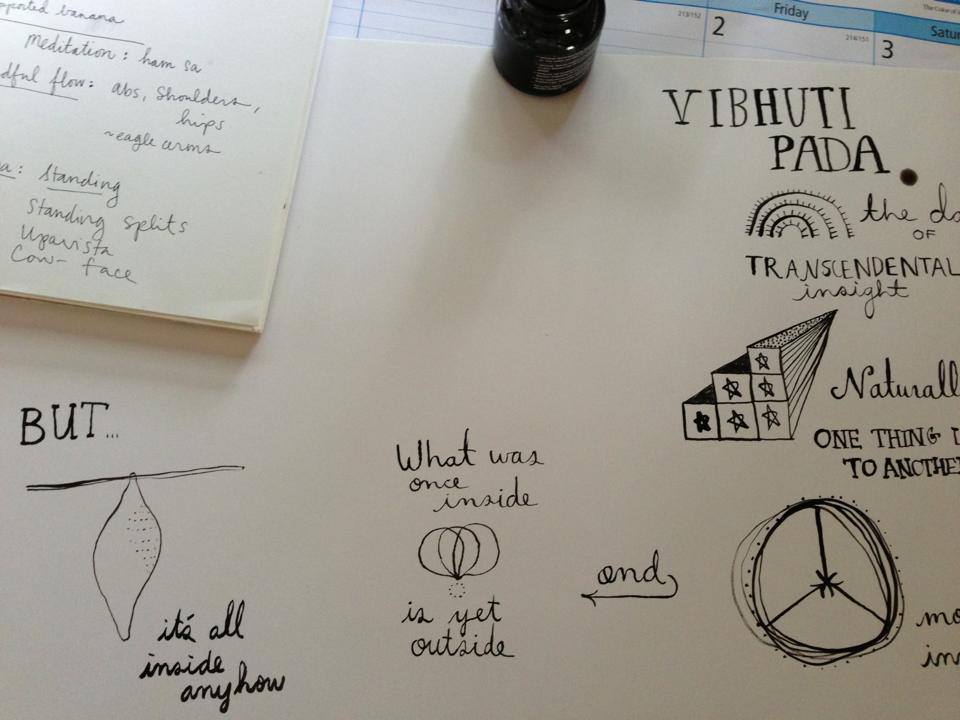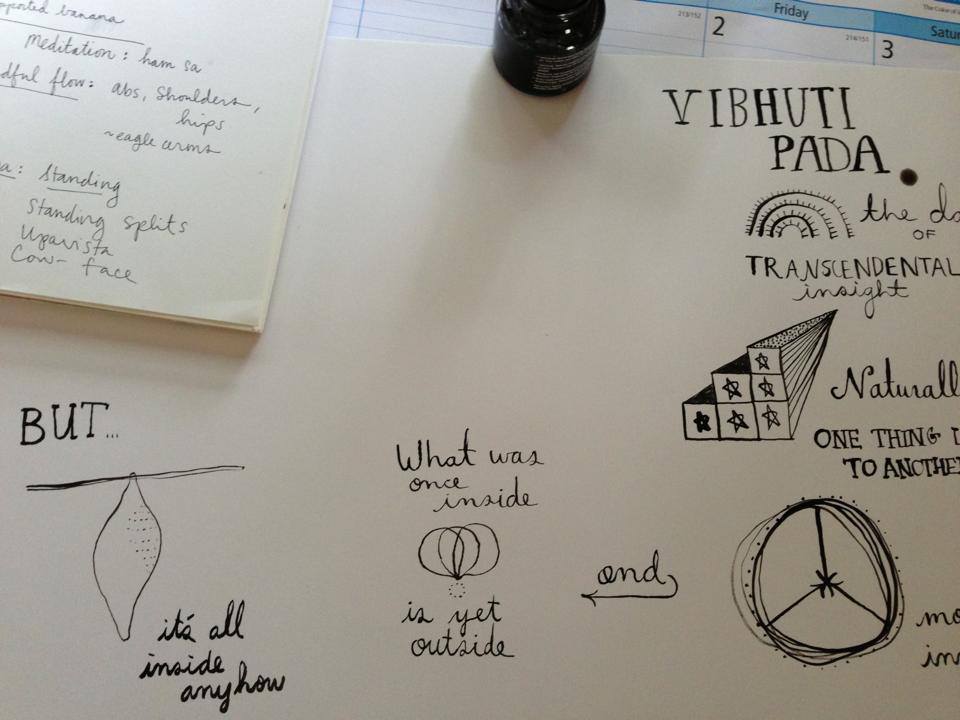This summer in my real-time/ in-person classes, we have been discussing the Eight Limbs of Yoga as described by the Yoga Sutras. If you are familiar with my classes, you may already know that we tend to focus on a philosophical theme for a period of time. Since I have been working on my own book about the Yoga Sutras for the past 9 months, we have worked with them more than any other text over the past year.
There are times when I feel very shy about introducing the Yoga Sutras in class. On one hand, I think many students may feel bored or even slighted by a robust philosophical discussion before we dive into our physical practice. On the other hand, I worry that there is not time enough to pay each topic its due and therefore the whole idea is a fruitless endeavor. This is just my stuff. I know. Most of the time, the message reaches the recipient it is intended to and is simply left alone by everyone else. This is a lodestar of my teaching. Keep chopping wood, and people who need wood will walk through the door.
So, on with the show. We are working with the Yoga Sutras. So what are they?
The Yoga Sutras are a compilation of 196 aphorisms (short statements) that illuminate (generally) the states of being that are Yoga as well as practices that may reveal or cause us to remember the way back to those states of being. These sutras (Sanskrit for “threads”) are organized into four chapters (Padas). For now, I’ll simply state them. We can revisit and go deeper later. As I write subsequent posts, I will provide links here.
-
Samadhi Pada: On Being Absorbed in Spirit
-
Sadhana Pada: On Practices for Being Immersed in Spirit
-
Vibhuti Pada: On Mystical Gifts & Abilities
-
Kaivalya Pada: On Absolute Freedom
Who wrote the Yoga Sutras?
The Sutras are attributed to Maharishi Patanjali, though it is widely understood that Patanjali acted more as an editor. The Yoga Sutras are thought to have been passed from teacher to student orally. Patanjali in a sense, then, codified the teachings– freezing them through the written word in the language and usage of his time.
So when was his time?
There is disagreement here, with some scholars saying that Patanjali wrote down the Sutras in the Second Century, B.C. and others concluding that Patanjali’s work was produced between and the Second and Third Century, C.E.
Resources
There are many translations of the Yoga Sutras available today. On top of that, there are a great many scholarly comments written on the Sutras. The following are various texts, articles and podcasts I think are useful.
Translations of the Yoga Sutras
My experience has been that every translation and interpretation brings with it something unique from its author’s experience, space and time. For now, I’m including all of the translations I have read. Personally, I would not recommend all of these; where that is the case, I say so.
Edwin Bryant:: The Yoga Sutras of Patañjali: A New Edition, Translation, and Commentary. This book is fantastic. It combines a translation with a compilation of the traditional commentaries along with Bryant’s thoughts. He is a scholar, through and through, and I think this version is absolutely necessary for a long-term, serious look into the Yoga Sutras.
TKV Desikachar:: The Heart of Yoga: Developing a Personal Practice. Very clear translation and straightforward commentary. The sutras are but one part of this book. It is a gem!
Nischala Joy Devi:: The Secret Power of Yoga: A Woman’s Guide to the Heart and Spirit of the Yoga Sutras
Nischala Joy Devi’s Yoga Sutras are poetry! Her words fill the sutras with sweetness. Many of the negatives (nonharming, nonstealing, etc.) are rephrased in positive terms in her version. This is not a complete translation of the sutras, but I think it provides a delightful supplemental interpretation. Also, I don’t think men should be put-off by the title. It is not strictly for women, but offers a feminine perspective.
Chip Hartranft:: The Yoga-Sutra of Patanjali: A New Translation with Commentary (Shambhala Classics)
Hartranft approaches from a Buddhist perspective, which is good to keep in mind while reading. It includes a synthesis of the traditional commentators in a condensed format. I think this is a great book for people who want to read in historical context without committing to Bryant’s book. The writing is very clear.
Ravi Ravindra:: The Wisdom of Patanjali’s Yoga Sutras: A New Translation and Guide by Ravi Ravindra
This is my favorite. The translation is at once beautiful and essential: the commentary wise.
Matthew Remski:: Threads of Yoga: A Remix of Patanjali’s Yoga Sutras With Commentary & Reverie. SO good. Post-modern poetry. My copy is shredded from all of the love I have given it. I do think this is a wonderful companion,
Geshe Michael Roach & Lama Christie McNally:: The Essential Yoga Sutra: Ancient Wisdom for Your Yoga. This one is tricky for me. I had a really hard time reading it because of the tragic story surrounding these two and McNally’s deceased husband. This version offers examples of modern applications of the sutras, but I find the language a bit jargon-y.
Mukunda Stiles:: Yoga Sutras of Patanjali. I bought this version in 2006 and it was my go-to for years. My understanding of the Sutras opened up when I started reading other translations. The language is a bit unclear at times. Section One is an English translation of the Sutras and Section Two breaks down the translation from Sanskrit. The introduction is well-written and helpful. I recommend it for Section Two.
Books about Yoga that Assist in Reading the Yoga Sutras
BKS Iyengar:: The Core of the Yoga Sutras. I think this book is most helpful if you have already read a few translations and commentaries. What I find most wonderful about this book is that it is a reflection of 94-year old Iyengar’s thoughts on the Sutras right now. He talks about how he has had new insights over the past two or three years that lead him to write the book. Even if the book sheds no new light for the reader, I think it is telling just how potent we can be at any age if we are open to change.
Nicholai Bachman:: The Path of the Yoga Sutras: A Practical Guide to the Core of Yoga. While I’m not crazy-in-love with Bachman’s rendition of the Sutras, this book is fantastic. It deconstructs the Sutras, then arranges them thematically. I think it works quite beautifully.
Rolf Gates:: Meditations from the Mat: Daily Reflections on the Path of Yoga. I think this book is a wonderful way to begin thinking about one’s yoga practice beyond the mat. I find Rolf Gates’ voice extremely readable and relatable. This is a book I have given and recommended many times over to new yoga students.
Articles, Notes & Comments about the Yoga Sutras
- A really thoughtful review of Matthew Remski’s remix of the Sutras at Dancing Crow Yoga. (Remski’s book is one of my favorites.)
- An article by Carol Horton about why the Yoga Sutras are not “Prime-time” material.
- I really enjoy reading Amanda Green’s thoughts on living the Yoga Sutras. She is real.
- Raja Sutras is a neat compilation site. I need to dig through this more.
- The Garden at Lulu Bandhas is a great forum site with lots of posts on teaching and applying the Yoga Sutras.
Yoga Classes Introducing Concepts from the Yoga Sutras
- (Most of my classes reference the Sutras, but here are a few that introduce major concepts.)
- Limbs of Yoga
- Kleshas
- Siddhis
Are there versions or resources you would add to this list? Please connect so that I can read them! I would love for this to be a living post, with many updates. It wants your voice!
LOVE.
{P.S. The links to amazon include affiliate links.}


11 thoughts on “The Yoga Sutras// An Introduction & Resource Hub”